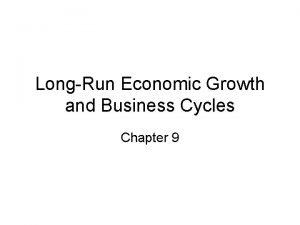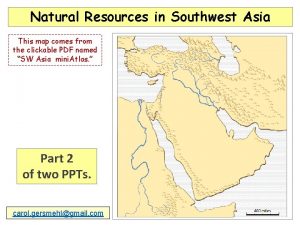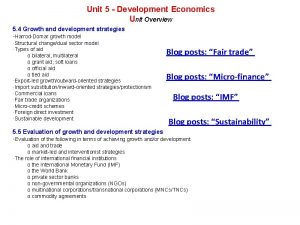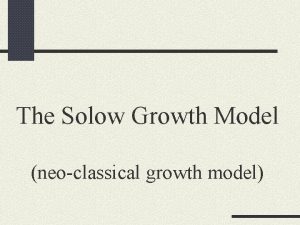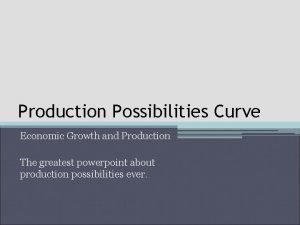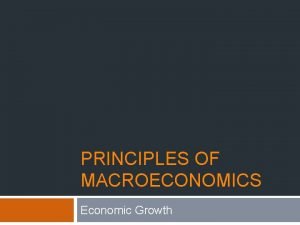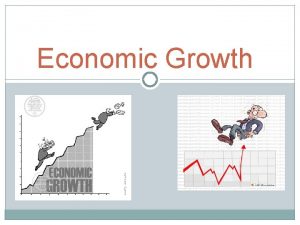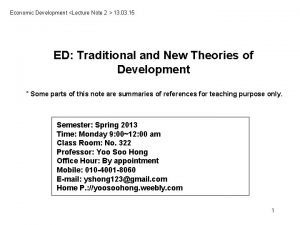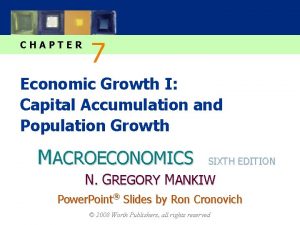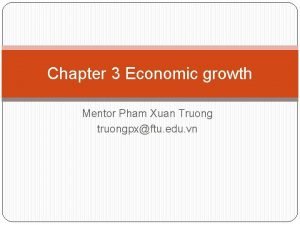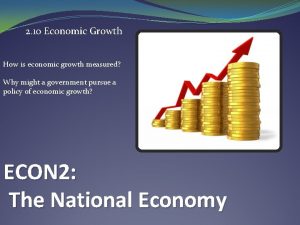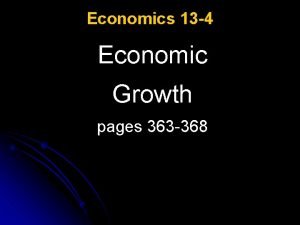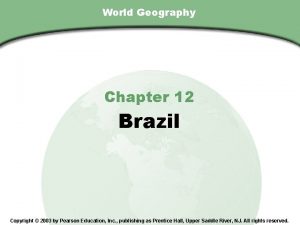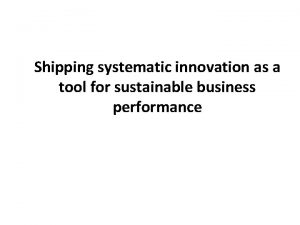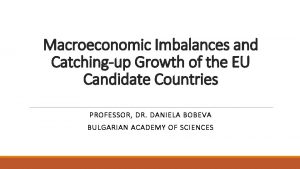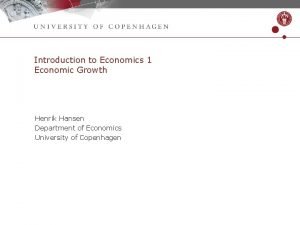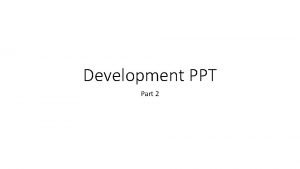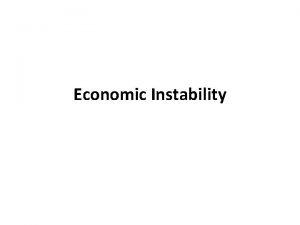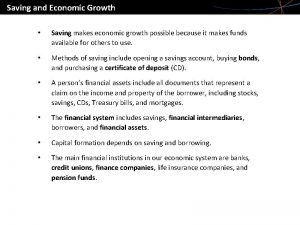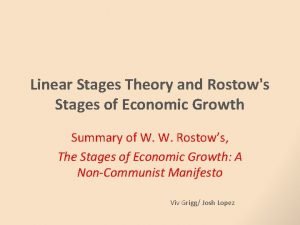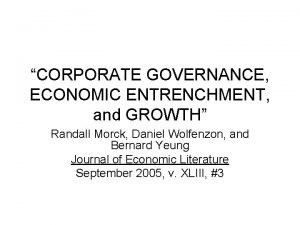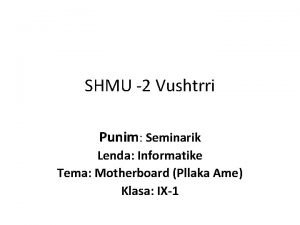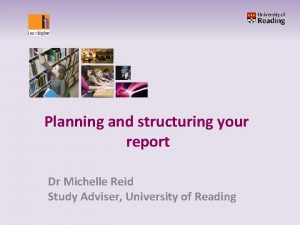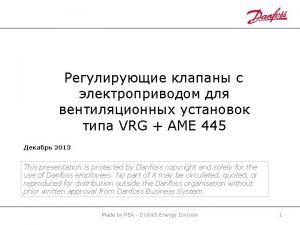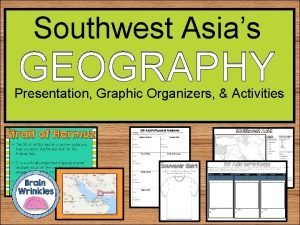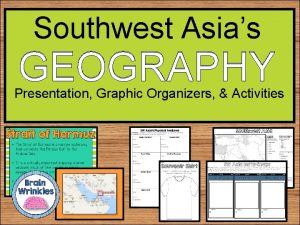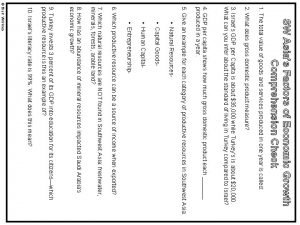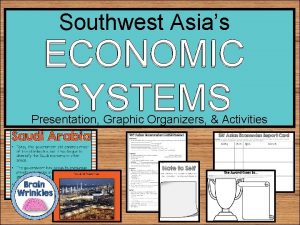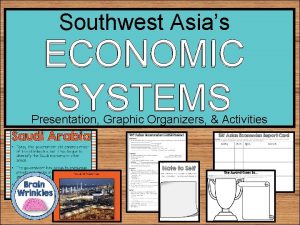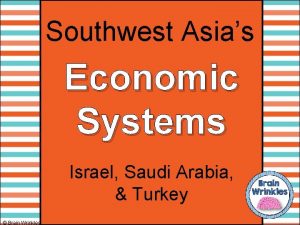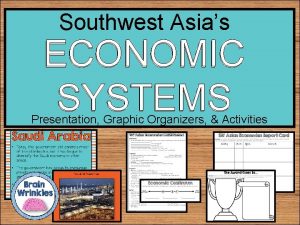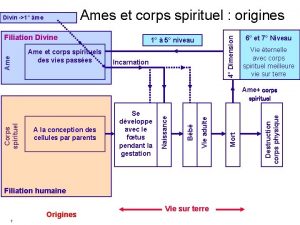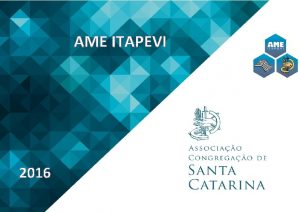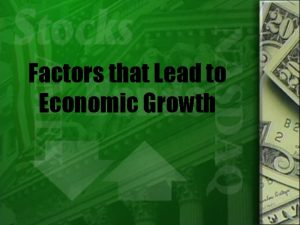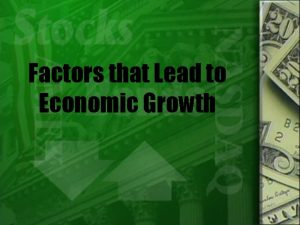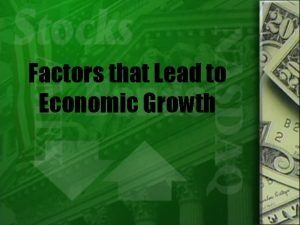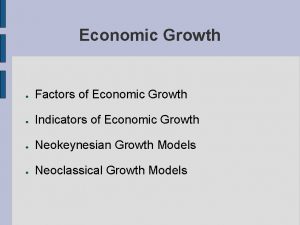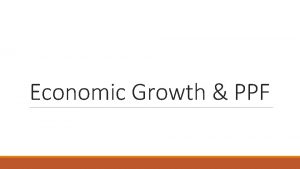Southwest Asias Factors of Economic Growth Ame Natural

















































- Slides: 49

Southwest Asia’s Factors of Economic Growth Ame Natural Resources, Capital Goods, Human Capital, & Entrepreneurship © Brain Wrinkles

GDP • Economists measure the strength of a country’s economy by its gross domestic product (GDP). • A country’s GDP is the total dollar value of all goods and services produced in one year. • Some countries have a high GDP, while others do not. © Brain Wrinkles

Per Capita • GDP is often measured as “GDP per capita” (per person). • Countries with a higher GDP per capita have stronger economies, while countries with lower GDP per capita have weaker economies. © Brain Wrinkles

SW Asia GDP • For the most part, the GDP per capita in the Southwest Asia region tends to be lower than the figures found in Europe or the United States. • However, the GDP per capita (for most countries) is higher than that of most African countries. • GDP per capita varies widely throughout the region. © Brain Wrinkles

SW Asia GDP per Capita • Iran $17, 600 Iraq $15, 400 Israel $34, 500 Jordan $11, 000 Saudi Arabia $54, 500 Syria $2, 900 Turkey $20, 700 United States $59, 531 What can you infer about the standard of living of these countries compared to that of the United States? © Brain Wrinkles

Productive Resources • A nation’s productive resources determine the strength of its economy. • Productive resources are the materials and labor used to create goods and services. • The four main categories of productive resources are natural resources, human capital, capital goods, and © Brain Wrinkles entrepreneurship.

NATURAL RESOURCES © Brain Wrinkles

Natural Resources • Natural resources are the materials that come from nature, such as land, forests, minerals, water, etc. • They play an important role in a country’s economy because they are fuel for industry and are a source of income when exported to other countries. © Brain Wrinkles

Resource Distribution in Southwest (and Central) Asia © Brain Wrinkles

Crude Oil in Saudi Arabia © Brain Wrinkles

Natural Resources • The availability of natural resources in a country greatly affects which industries develop there. • Southwest Asia lacks in some natural resources like fresh water and forests, but resources like oil and arable land have greatly affected the development of those industries in the region. © Brain Wrinkles

Key Products Israel Saudi Arabia Turkey Fruits Oil Tobacco Vegetables Natural gas Cotton High-Tech Equipment Petrochemicals Automobiles Electronics Barley Electronics Pharmaceutical s Wheat Aircraft © Brain Wrinkles

Cotton in Turkey © Brain Wrinkles

CAPITAL GOODS © Brain Wrinkles

Capital Goods • Capital goods are the man-made materials that are needed to produce goods and services. • Some examples of capital goods include factories, machinery, technology, buildings, tools, etc. • The more a country invests in its capital goods, the stronger its economy and higher the GDP. © Brain Wrinkles

© Brain Wrinkles

Capital Goods • Investment in better machines, updated factories, and new technology leads to more goods and services being produced. • This boosts a country’s exports and its gross domestic product. • Investment in capital goods typically leads to an increase in GDP per capita. © Brain Wrinkles

Israel • Israel, Saudi Arabia, and Turkey have encouraged capital investments in order to aid their economies. • Israel has invested heavily in capital goods of agriculture and technology (medical, agricultural, mining and electronics). • The government also provides financial benefits foreign companies making capital investments in the country. © Brain Wrinkles

Saudi Arabia • Saudi Arabia has invested heavily in capital goods, especially in the technology related to oil production, transportation, and communication. © Brain Wrinkles

Saudi Oil Refinery © Brain Wrinkles

Turkey • Turkey’s investments have been in agriculture in the past, but that investment has recently shifted to industry (textiles, equipment, metal manufacturing). • Turkey is looking to increase its capital investment by bringing in more foreign investors. © Brain Wrinkles

HUMAN CAPITAL and Literacy Rate © Brain Wrinkles

Human Capital • Some of a country’s most important resources are its people. • Countries need skilled workers to fill jobs within the economy. • It takes different kinds of human capital to make different kinds of goods and services. • For example, doctors, teachers, and factory workers all have a different set of skills and they each help to produce different goods or services. © Brain Wrinkles

© Brain Wrinkles

Human Capital • Investments in human capital, such as education and professional training programs, are a great way for a country to improve its GDP. • In order to have long-lasting economic growth, a country must have a smart, highly-skilled workforce. • Education also improves a country’s standard of living. © Brain Wrinkles

© Brain Wrinkles

SW Asia • Israel, Saudi Arabia, and Turkey have all made investments in education that have made their economies grow. • Their workers are trained, skilled, and can communicate well. • Israel and Saudi Arabia both invest about 7% of their GDPs in education, which is on par with the world average. © Brain Wrinkles

Israel • Education is important in Israel, and the country offers free education through 12 th grade. • Israel also invests in excellent universities. © Brain Wrinkles

Hebrew University of Jerusalem © Brain Wrinkles

Saudi Arabia • In the past, Saudi Arabia’s education was limited to a very few in select Islamic schools. • Today, the country has public education through the college level open to every Saudi citizen. © Brain Wrinkles

Turkey • Turkey only invests about 3% of its GDP on education, which is lower than the world average. • However, the government pays for free public schools through grade 12. • There also more than 160 universities in the country. © Brain Wrinkles

Literacy • A country’s literacy rate is the percentage of adults who can read and write. • Countries with high literacy rates enjoy a high standard of living (the level of wealth and material comfort available). • Educated and skilled workers are an important factor in a country’s economic growth. © Brain Wrinkles

© Brain Wrinkles

Literacy • If you can read, you can learn and improve your work skills to get a better job that pays a higher salary. • With a better salary, you can improve your standard of living. • A country that improves the literacy rate among its citizens will also improve the standard of living and economy. © Brain Wrinkles

Literacy Rate • Southwest Asia’s literacy rates are generally higher than the worldwide average (86. 3%), which shows each country’s commitment to education. Country Literacy Rate Israel Saudi Arabia Turkey 99% © Brain Wrinkles 94. 7% 95%

Literacy • The countries’ investments in education and training have led to: • higher literacy rates, • a higher standard of living, • a lower level of poverty, • and a lower level of unemployment. © Brain Wrinkles

Middle School Students in Saudi Arabia © Brain Wrinkles

ENTREPRENEURSHIP © Brain Wrinkles

Entrepreneurship • An entrepreneur is someone who takes risks to start a new business. • Entrepreneurs produce fresh ideas for goods or services and then they use natural resources, capital goods, and human capital to bring those ideas to life. • They help the economy grow by opening new businesses and developing new products, which creates more jobs. © Brain Wrinkles

Loulou Khazen Baz is the founder and CEO of Nabbesh. com, which is the Middle East’s first online work marketplace that connects businesses with top quality freelancers. Nabbesh. com has a community of more than 40, 000 people across 130 countries worldwide. © Brain Wrinkles

Entrepreneurship • It is risky and expensive to be an entrepreneur because they often invest their own money (or borrow it) to start their business. • There is no guarantee of success, and if the business fails, they could lose money. • Some countries encourage entrepreneurship by trying to reduce the © Brain Wrinkles

Ralph Debbas is the founder and CEO of W Motors, which is the Arab world’s first manufacturer of high performance luxury sport cars. The company auctioned its first vehicle, a Lykan Hyper. Sport, for $3. 4 million. (This was the most expensive car to be featured in the Fast and Furious franchise. ) © Brain Wrinkles

Entrepreneurship • If a country’s government imposes a lot of regulations on businesses, it can be really hard on an entrepreneur. • Having an environment that promotes entrepreneurship is a great advantage to a country. © Brain Wrinkles

As a former Olympic swimmer, Hind Hobeika saw a gap in the market for a swimming-tracking device. In 2011, she established a company named Instabeat, which is a sports technology startup based in Lebanon. © Brain Wrinkles

Israel • Israel has created a positive environment for entrepreneurs. • The country has more start-up companies per capita than any country in the world. © Brain Wrinkles

Ronaldo Mouchawar is the co-founder and CEO of the largest ecommerce site in the Arab world, Souq. com. His website was launched 10 years ago as an online auction site and is now regarded as the “Amazon. com” of the Middle East. © Brain Wrinkles

Turkey & Saudi Arabia • Turkey has also been working hard to foster entrepreneurship and has a growing technology start-up sector. • Saudi Arabia’s government promotes entrepreneurship; however, new businesses still face many government regulations and lack of skilled workers. © Brain Wrinkles

Khalid Al Khudair is the current Founder and CEO of Glowork which is a women empowerment organization that has created thousands of jobs for women. Glowork boasts a database of over 1. 2 million Saudi women and has connected thousands with jobs. © Brain Wrinkles

Entrepreneurship • The worldwide average for starting a new business takes 21 days and the overall business freedom is 65%. Israel Saudi Arabia Turkey Starting a new business takes… 12 days 16 days 7 days Overall Business Freedom 70% 74% 64% © Brain Wrinkles
 Yellow sea and east china sea
Yellow sea and east china sea Economic growth vs economic development
Economic growth vs economic development Economic growth and development
Economic growth and development Factors of economic growth
Factors of economic growth How would you describe this
How would you describe this What is plant growth analysis
What is plant growth analysis Monocots eudicots
Monocots eudicots Growthchain
Growthchain Primary growth and secondary growth in plants
Primary growth and secondary growth in plants Vascular ray
Vascular ray Geometric growth vs exponential growth
Geometric growth vs exponential growth Neoclassical growth theory vs. endogenous growth theory
Neoclassical growth theory vs. endogenous growth theory Difference between organic and inorganic growth
Difference between organic and inorganic growth Harrod domar growth model
Harrod domar growth model Solow growth model
Solow growth model Interest rates and economic growth
Interest rates and economic growth Ppc curve economic growth
Ppc curve economic growth Long run economic growth
Long run economic growth Long run economic growth
Long run economic growth Rostow's development model
Rostow's development model Solow model of economic growth
Solow model of economic growth Solow model of economic growth
Solow model of economic growth Short run economic growth graph
Short run economic growth graph Importance of economic growth
Importance of economic growth Brazil's quest for economic growth
Brazil's quest for economic growth Economic growth is defined as
Economic growth is defined as Economic growth is defined as
Economic growth is defined as Economic growth and development
Economic growth and development Economic growth occurs when
Economic growth occurs when Models of community development ppt
Models of community development ppt Economic growth trends
Economic growth trends Economics chapter 13 vocabulary
Economics chapter 13 vocabulary Saving makes economic growth possible because
Saving makes economic growth possible because Linear stage theory
Linear stage theory Corporate governance and economic growth
Corporate governance and economic growth Economics unit 1 lesson 2 difficult choices
Economics unit 1 lesson 2 difficult choices Ame church emblem
Ame church emblem Que tes vives eaux inondent mon âme paroles
Que tes vives eaux inondent mon âme paroles Dieu seul suffit que rien ne te trouble paroles
Dieu seul suffit que rien ne te trouble paroles Petrit ame
Petrit ame Ame lab 2
Ame lab 2 Maria rosa guerrini
Maria rosa guerrini Qka eshte pllaka ame
Qka eshte pllaka ame Shmu 2 vushtrri
Shmu 2 vushtrri Dr michelle reid husband
Dr michelle reid husband Komponentet e motherboard
Komponentet e motherboard Ame 445
Ame 445 Mon ame est attache a toi
Mon ame est attache a toi Usc ame
Usc ame Je me tiens à la porte
Je me tiens à la porte



